The Kalanchoes are a group of plants that have been used for centuries in the tropics as ornamental houseplants. Native to Madagascar, the genus of this popular succulent houseplant has more than one hundred plant species in its family.
These lovely flowering plants thrive in the driest of climates, and they are popular in homes because they’re easy to care for. Available for purchase in a wide variety of locations including, florists, nurseries, and even grocery stores, a flowering Kalanchoe can be found in white, yellow, pink, or red.
It is particularly present during holidays, often sold in attractive arrangements, baskets, or containers as an attractive and thoughtful gift.
If you want to grow this beautiful houseplant, keep reading to learn how to care for the kalanchoe plant.
Kalanchoe Plant Overview
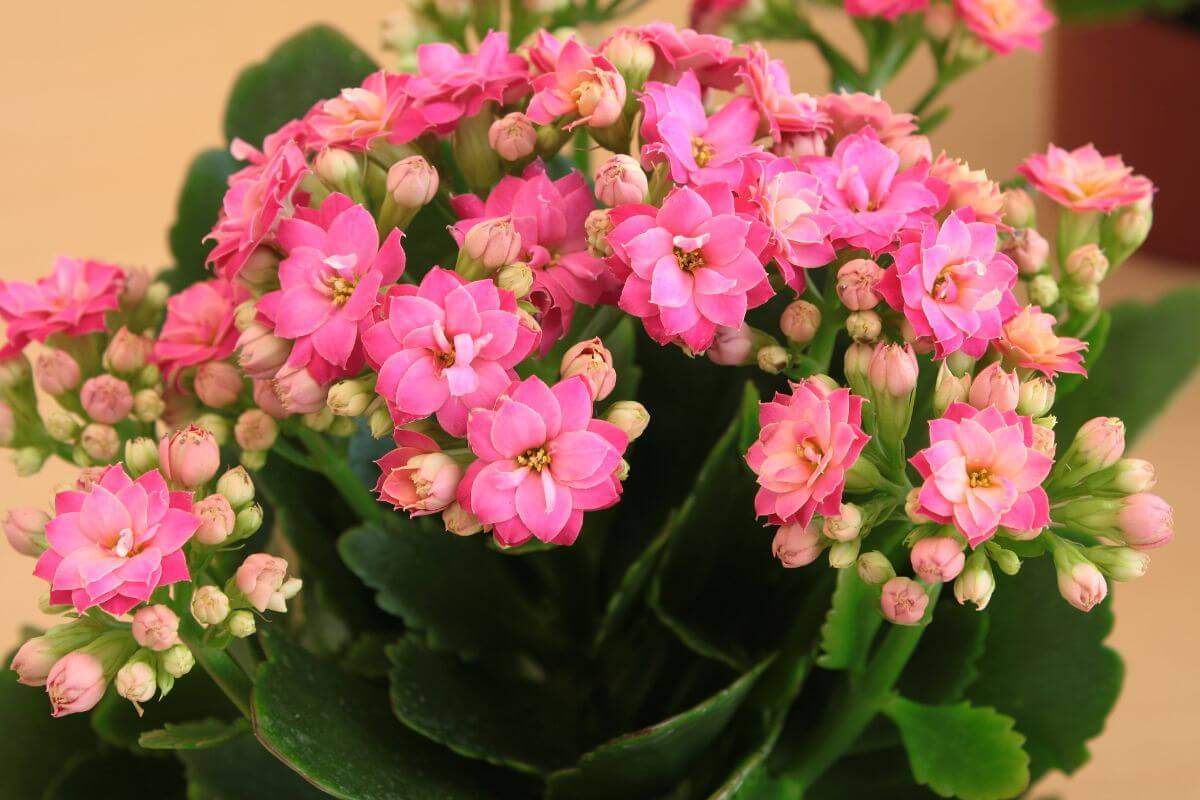
The kalanchoe plant has attractive foliage and flowers that will bloom throughout the year when given access to adequate daylight.
This plant is a slow grower and may need anywhere from two to five years to reach its full maturity. When grown to maturity, it may reach a height of 1-1.5 feet tall, as well as wide.
A member of the Crassulaceae family, it is botanically known as the Kalanchoe blossfeldiana. It has many popular names for various varieties: Kalanchoe, Christmas Kalanchoe, Mother-in-Law plant, Flaming Katy, Devil’s Backbone, Mother of Millions, Panda Plant, Chandelier Plant, Widow’s Thrill, and more.
Popular varieties of Kalanchoe include:
- Kalanchoe beharensis – Prized for large-sized leaves that are velvety in texture and tinted in a pale green and silvery hue.
- Kalanchoe blossfeldiana – The most popular and well-loved of the Kalanchoes, the “blossfeldiana” has large blooms in a multitude of colorful flowers. Their natural flowering period is in the springtime, but they can and do flower throughout the year.
- Kalanchoe manginii – Fleshy leaves distinguish this variety, along with full pendant flowers shaped like a bell. For the “manginii” to continue flowering, it requires consistently moist air.
- Kalanchoe pinnata – This variety boasts green fleshy foliage and sprouts petite plantlets around its base.
- Kalanchoe porphyrocalyx – Often referred to as “Pearl Bells,” this type is characterized by slender, rectangular-shaped leaves with purple-hued pendant flowers.
If you are interested in an easy to care for potted plant with added beauty and color, look no further than the Kalanchoe.
Kalanchoe Plant Care
The kalanchoe does not ask a lot of its owners, opting for lots of sunlight and a well-draining soil bed. It can tolerate varying temperatures, but will not flower during the winter.
When spring rolls around, you get to welcome many colorful blooms that will last for a few weeks and can flower again during the year with the right conditions. Good light levels, pruning, and reduced watering will contribute to your plant producing flowers.
Soil for the Kalanchoe
A soil bed of fifty percent cactus mix and fifty percent potting mix will keep your kalanchoe happy. You can also blend a combination of forty percent perlite and sixty percent peat moss, and your plant will be fine.
The soil must be well-draining and should not retain excess moisture. Overly moist locations should be avoided. Terracotta clay pots with drainage holes will help wick away any excess water and provide well-drained soil.
Light for the Kalanchoe
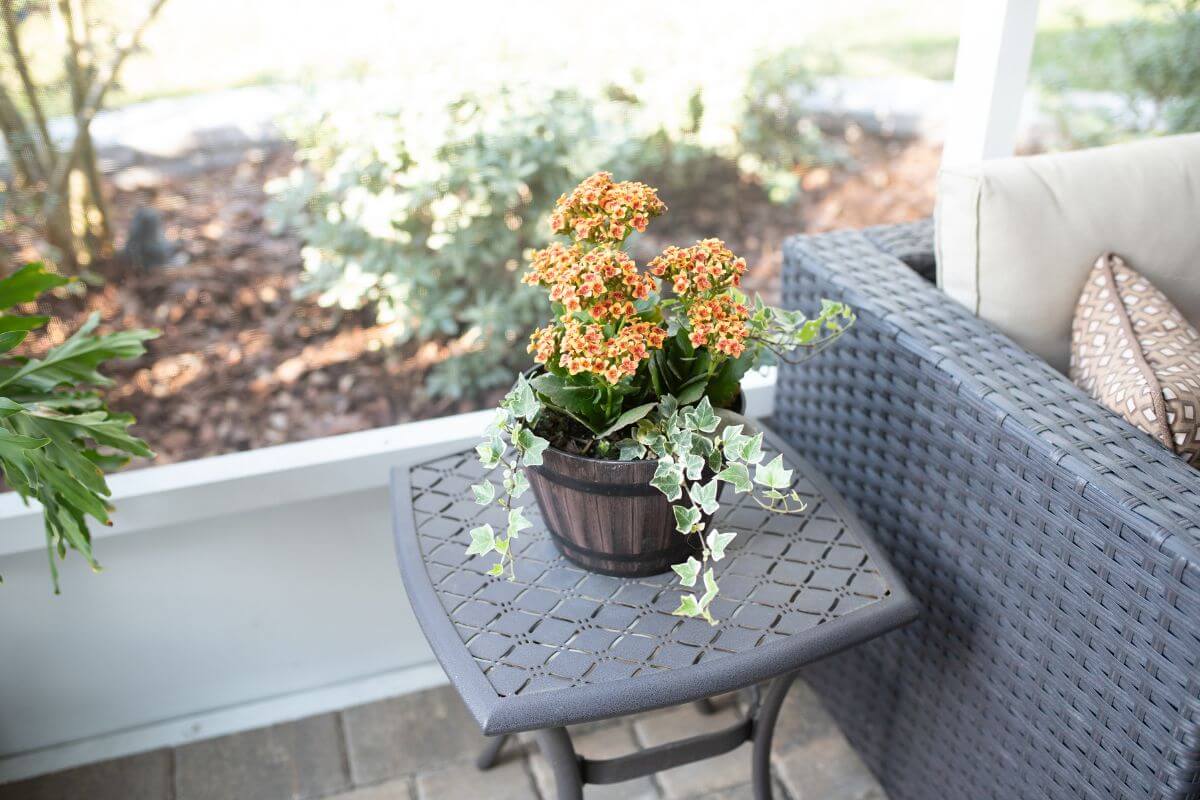
Lots of light is the rule for kalanchoe care. Your plant should be positioned in a sunny corner where there is a lot of natural light to be had.
Windowsills might be avoided to prevent the risk of scorching their fleshy leaves and inhibiting flowering.
Temperature for the Kalanchoe
Environmental temperatures sitting between 55 and 80° Fahrenheit is perfect for normal kalanchoe plants.
Water and Humidity for the Kalanchoe
If you often forget to water indoor plants, you and the kalanchoe are a match made in heaven. As a succulent Kalanchoe stores water in its leaves, so even if you’re late in watering, this plant is a survivor.
Kalanchoes do exceptionally well with very little water. It can be watered once every several weeks and then left to itself. Watering saturation should be reduced during the winter months.
The soil bed should be allowed to dry out completely between waterings. This will help prevent root rot from setting in.
If you don’t know if the plant is ready for a new watering, stick your finger a few inches into the soil. If you feel moisture, do nothing and check again after several days.
While not a fussy plant, the environment is important. It does not require specific humidity levels to thrive. These plants do not need to be regularly sprayed or misted, but an annual spray can be a great way to clean out pores.
Fertilizer for the Kalanchoe
As a flowering succulent, a taste of fertilizer will be advantageous for your plant, particularly during the flowering period.
A well-balanced fertilizer given once a month during the spring and summer months will make for a happy plant. If you want to increase your kalanchoe’s blooming potential, select a blended fertilizer that has potassium among its ingredients. This should help with flowering, during the next bloom.
A light top dressing of the soil bed with compost or worm castings in spring is very nutritious for your Kalanchoe as an alternative to liquid fertilizer. Over-fertilization will lead to burning the tips of the leaves.
Second Bloom – How to Get the Kalanchoe to Bloom
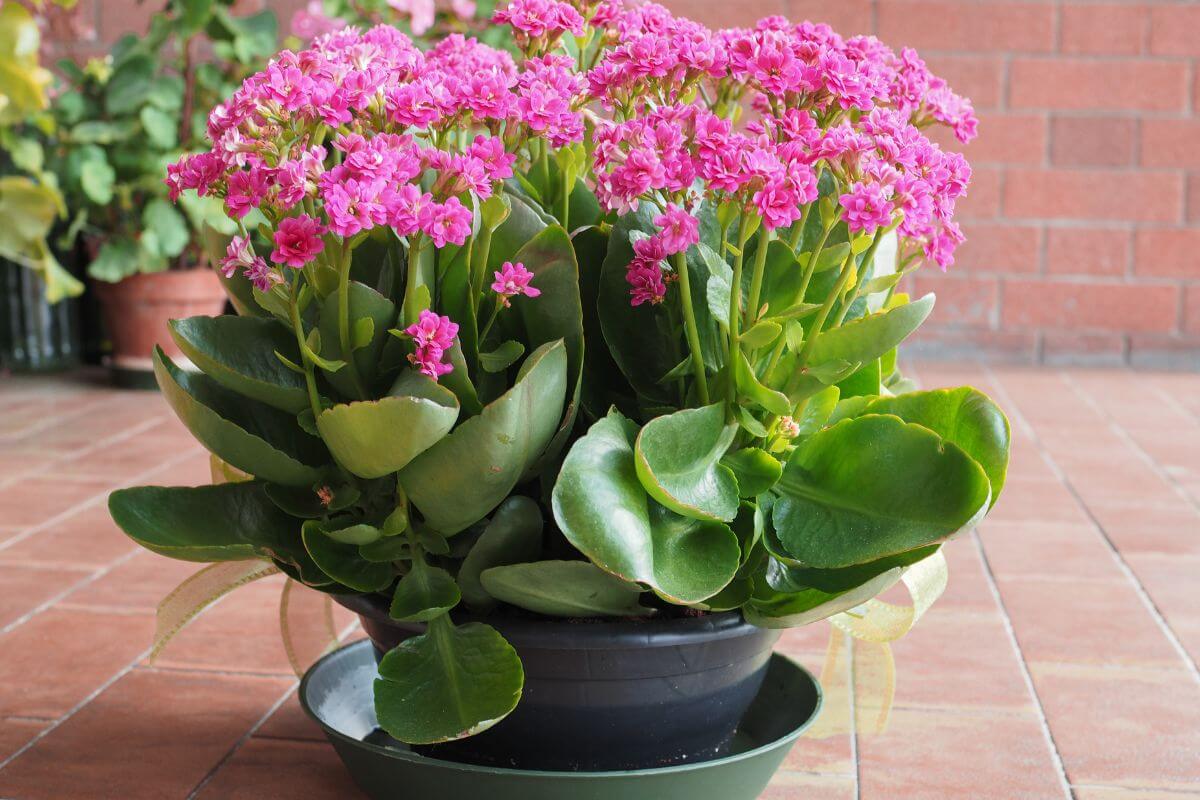
While the plant will flower naturally in the springtime, it has the ability to bloom more often. If you wish to get a second bloom time, you will need to fool your Kalanchoe that it has already experienced winter.
The period from October to March features short days that naturally instigate flower buds. That’s why it’s known as a Short-Day Plant. The rest of the year, you will have to replace Mother Nature if you want a bloom.
Here are the steps to get that second bloom:
- Leave your Kalanchoe out in the morning for its daily dose of light.
- Then remove it and place it in a closet or very dimly lit room for the rest of the day.
- A kalanchoe will need twelve to fourteen hours of darkness daily for at least six weeks to form new blooms.
Kalanchoe Pruning and Repotting
To create a compact plant, cut the stems where the flowers are spent. Then pinch back any growth that begins to appear leggy.
Kalanchoes rarely require repotting. However, it is good practice to repot them approximately every two years to transfer your kalanchoe to a new pot with fresh potting mix.
Even when your plant appears to be in great health, repotting it ensures future growth and health. Repotting should be done at the beginning of the growing season.
Kalanchoe issues that lead to a need for repotting include:
- The plant is root bound.
- The soil bed dries out too rapidly, meaning it cannot retain any moisture.
- The plant appears unhealthy and you have not found problems connected to light conditions, watering, or pest infestations.
If roots appear damaged or decayed, trim them before repotting.
Propagating the Kalanchoe
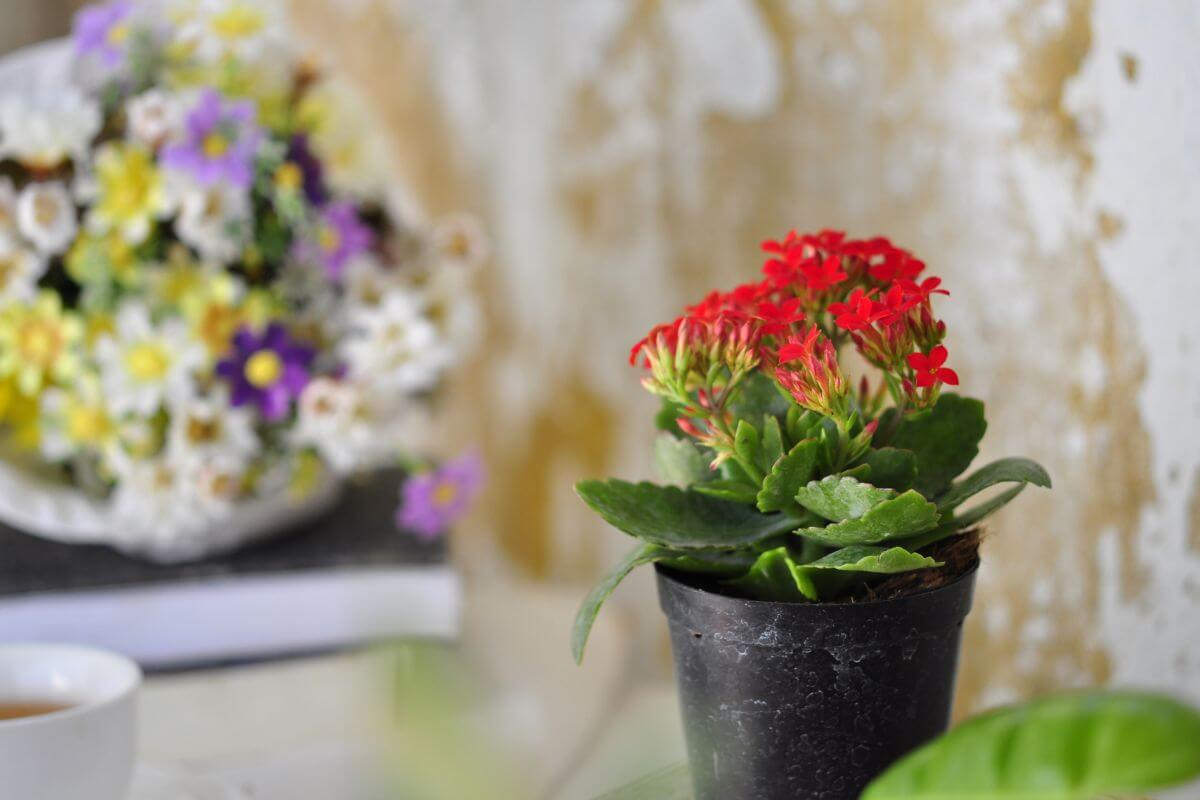
Here’s how to propagate a kalanchoe plant:
- Cut a piece of a stem several inches in length from a mature plant.
- Set it aside to dry out for several days, or until the cut end appears healed or closed.
- Plant the stem cutting in a soil bed as described above in the soil section. Use either a potting soil and cactus soil mix, or peat moss with perlite.
- Do not water it but rather allow it to sit. The stem should show some root growth in approximately a month.
Kalanchoe Toxicity and Pets
Unfortunately, the kalanchoe is considered highly toxic to animals such as dogs, cats, and livestock. Both the flowers and the leaves of the Kalanchoe contain bufadienolides.
If your pet ingests kalanchoe, severe symptoms of poisoning may follow quickly, including:
- Diarrhea
- Vomiting
- Abnormal heart rhythm
Kalanchoe should be kept out of the reach of domestic pets. If you know that your pet has eaten some part of this plant, or suspect as much, contact your veterinarian immediately.
Kalanchoe Pests, Diseases, Problems and More
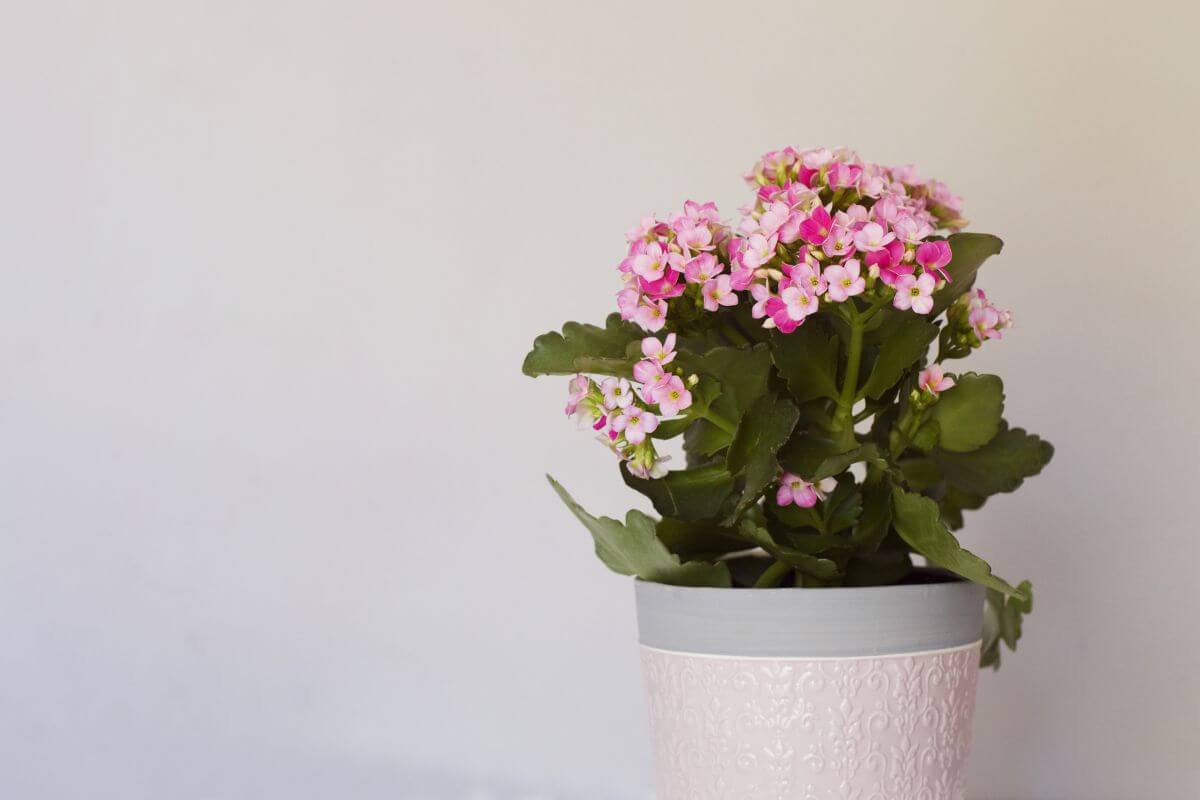
If you move your Kalanchoe outdoors, especially in the warmer weather, it may be subject to visits from mealybugs and aphids. A very light application of neem oil that has been diluted should manage pest problems.
If brown patches begin to appear on the kalanchoe’s leaves, it is probably due to sunburn from excessive exposure to direct sunlight. Move it to a brightly lit spot that has indirect sunlight.
A wilting kalanchoe may indicate that it’s not warm enough. This plant should be kept away from drafts and moved to a warmer spot. Also, check to make sure you are not overwatering.
Mushy, brown stems mean rot that is due to overwatering. This can be a death knell for a succulent. Remove any affected areas on the plant and allow the soil bed to dry out completely before watering again.
Kalanchoe Plant Care Final Thoughts
The sculpted foliage of this handsome succulent makes it an attractive plant all year round, even when not in bloom. With the different flowering varieties, the colorful starry-shaped blooms will add a bit of pizzazz to any decor, and they are long-lasting as flowers go.
The low-maintenance requirements make it a wonderful plant, especially for beginners and people with little time available for gardening, but still want some greenery at home or work.
Other houseplants with complete care guides to read about
Kalanchoe Plant Care FAQs
Does kalanchoe like full sun?
Yes, kalanchoe plants like full sunlight. Although if placed too close to windows, it could get burned by intense sunlight. It does best in partial shade.
How long will a kalanchoe live?
Most kalanchoes have a lifespan of a year, but can survive up to 10 years if well-taken care of. Most people will throw them out after the flowers bloom, so they don’t last long. Each year, the kalanchoe bloom will last for weeks. You can often get a second bloom out of the kalanchoe as well.
How long do kalanchoe flowers last?
Kalanchoe flowers usually last for a few weeks in the early spring. The natural timeline for kalanchoe blooms is in the late winter and early spring, but can be forced to bloom any time.
Can I put my kalanchoe outside?
You can place your kalanchoe outside during the summer months, although you should keep it protected from extreme heat and cold temperatures. During colder seasons, bring it inside until the temperature warms up. In the fall, remove it from its pot and store it indoors over the winter. When the new season arrives, repot in fresh soil and water regularly.
Why is my kalanchoe dying?
Two of the main reasons your kalanchoe is dying is due to overwatering or extreme temperatures. Be sure there isn’t too much water or moisture, nor is it too hot or cold. It’s also possible that your kalanchoe is suffering from nutrient deficiency.
How often should I water kalanchoe?
Water your kalanchoe every 2-3 weeks or when the soil is too dry. Stick your finger a few inches into the soil to check if it’s dry. If it’s still moist, no need to water and check it again in a few days. Kalanchoe plants don’t need a lot of water, but it’s still good to check them regularly.
How big does a kalanchoe plant get?
A mature kalanchoe plant may grow anywhere between 3 feet tall and 6 feet tall. Most kalanchoe plants are smaller and are only 1 to 1.5 feet tall, as well as 1-1.5 feet wide. A large one would easily fit in a 5 gallon container.
Are Kalanchoe daigremontiana leaves edible?
Yes and No. Kalanchoe plants are toxic to pets, but is edible to adult humans. Many people use the kalanchoe for medicinal benefits and as a supplement. It can be infused as a tea or made into a kalanchoe herbal juice.


